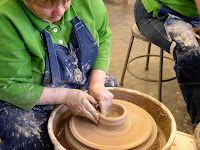To continue our posts on important historical references of great traditional hand building cultures for research we can group the americas as one- Meso and South American work and our own Native American pottery. These works have many elements in common. Pots were made for everyday use. Pottery also played a very important part in the social and spiritual elements of life. Two good books to begin with are "World Ceramics," by Hugo and Marjorie Munsterberg, and "A History of World Pottery," by Emmanuel Cooper. These books can be found in the school library.
Native American work from the Pueblo era in the southwest are still made in the same traditional way. The most famous of the Pueblo potters was Maria Martinez.
Sunday, February 14, 2010
Sunday, February 7, 2010
Empty Bowls
Yesterday was throwing day for our third "Empty Bowls." We began this annual fund raising event in 2008, thanks to Janelle's hard work and dedication. Empty bowls is a nationally supported, but locally organized effort by potters of many communities to help those who may not have the means for a sustaining daily meal. We continue to work to benefit and support the terrific people at Hope House.
Hats off to all of our continuing education students for once again giving their time and effort, making so many pots. Our community of potters is the best. A long day of throwing with lots of laughs and pots to (trim!) fill. More on the event will follow.
Friday, February 5, 2010
Iranian Ceramics

 An excellent book on early Iranian ceramics is authored by Trudy S. Kawami. "Ancient Iranian Ceramics" documents works from the Sackler Collections. I will bring my copy to our next class. For those of you wanting to add handles or spouts, these pieces may be a good start for design.
An excellent book on early Iranian ceramics is authored by Trudy S. Kawami. "Ancient Iranian Ceramics" documents works from the Sackler Collections. I will bring my copy to our next class. For those of you wanting to add handles or spouts, these pieces may be a good start for design.The Jomon book is now on reserve at the school library.
Monday, February 1, 2010
Variations in Salt Firing
The use of salt to glaze pots began in Germany during the 1500's. It is not known exactly how the idea came about. Stories of cod crates or maybe a smart chemist who made pots on the side are common. I don't know of any written accounts marking the first use of salt for glaze. But the expert on this is Jack Troy. His book on salt is still the best. Many of us started out with his book in hand as we began to revive this firing technique. There are a number of other good books on the subject. I will list them in the next post on salt.
Traditional salt glazing is still one of the great high fire experiences. So simple and direct. There are many ways to manipulate the effects at ∆10. Reduction, use of slips and washes, saggars and flashing are just a few of the basic approaches.
But an area that is not so commonly talked about is mid temperature salt or vapor firings. We do them here at PrattMWP in the sophomore classes. Sometimes we use terra cotta. This semester we will be using the ∆10 salt body I like from Sheffield Pottery,T-3S. I have used it at ∆ 3-6 will great results. We will get into more detail in a later post. Just a teaser for now.
Traditional salt glazing is still one of the great high fire experiences. So simple and direct. There are many ways to manipulate the effects at ∆10. Reduction, use of slips and washes, saggars and flashing are just a few of the basic approaches.
But an area that is not so commonly talked about is mid temperature salt or vapor firings. We do them here at PrattMWP in the sophomore classes. Sometimes we use terra cotta. This semester we will be using the ∆10 salt body I like from Sheffield Pottery,T-3S. I have used it at ∆ 3-6 will great results. We will get into more detail in a later post. Just a teaser for now.
Subscribe to:
Comments (Atom)















